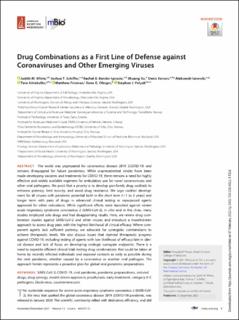| dc.contributor.author | White, Judith M. | |
| dc.contributor.author | Schiffer, Joshua T. | |
| dc.contributor.author | Bender Ignacio, Rachel A. | |
| dc.contributor.author | Xu, Shuang | |
| dc.contributor.author | Kainov, Denis | |
| dc.contributor.author | Ianevski, Aleksandr | |
| dc.contributor.author | Aittokallio, Tero Antero | |
| dc.contributor.author | Frieman, Matthew | |
| dc.contributor.author | Olinger, Gene G. | |
| dc.contributor.author | Polyak, Stephen J. | |
| dc.date.accessioned | 2022-03-10T10:08:37Z | |
| dc.date.available | 2022-03-10T10:08:37Z | |
| dc.date.created | 2022-01-27T04:03:19Z | |
| dc.date.issued | 2021 | |
| dc.identifier.citation | mBio. 2021, 12 (6), 1-20. | en_US |
| dc.identifier.issn | 2161-2129 | |
| dc.identifier.uri | https://hdl.handle.net/11250/2984201 | |
| dc.description.abstract | The world was unprepared for coronavirus disease 2019 (COVID-19) and remains ill-equipped for future pandemics. While unprecedented strides have been made developing vaccines and treatments for COVID-19, there remains a need for highly effective and widely available regimens for ambulatory use for novel coronaviruses and other viral pathogens. We posit that a priority is to develop pan-family drug cocktails to enhance potency, limit toxicity, and avoid drug resistance. We urge cocktail development for all viruses with pandemic potential both in the short term (<1 to 2 years) and longer term with pairs of drugs in advanced clinical testing or repurposed agents approved for other indications. While significant efforts were launched against severe acute respiratory syndrome coronavirus 2 (SARS-CoV-2), in vitro and in the clinic, many studies employed solo drugs and had disappointing results. Here, we review drug combination studies against SARS-CoV-2 and other viruses and introduce a model-driven approach to assess drug pairs with the highest likelihood of clinical efficacy. Where component agents lack sufficient potency, we advocate for synergistic combinations to achieve therapeutic levels. We also discuss issues that stymied therapeutic progress against COVID-19, including testing of agents with low likelihood of efficacy late in clinical disease and lack of focus on developing virologic surrogate endpoints. There is a need to expedite efficient clinical trials testing drug combinations that could be taken at home by recently infected individuals and exposed contacts as early as possible during the next pandemic, whether caused by a coronavirus or another viral pathogen. The approach herein represents a proactive plan for global viral pandemic preparedness. | en_US |
| dc.language.iso | eng | en_US |
| dc.publisher | American Society for Microbiology | en_US |
| dc.rights | Navngivelse 4.0 Internasjonal | * |
| dc.rights.uri | http://creativecommons.org/licenses/by/4.0/deed.no | * |
| dc.title | Drug Combinations as a First Line of Defense against Coronaviruses and Other Emerging Viruses | en_US |
| dc.type | Journal article | en_US |
| dc.type | Peer reviewed | en_US |
| dc.description.version | publishedVersion | en_US |
| dc.source.pagenumber | 1-20 | en_US |
| dc.source.volume | 12 | en_US |
| dc.source.journal | mBio | en_US |
| dc.source.issue | 6 | en_US |
| dc.identifier.doi | 10.1128/mbio.03347-21 | |
| dc.identifier.cristin | 1990889 | |
| cristin.ispublished | true | |
| cristin.fulltext | original | |
| cristin.qualitycode | 1 | |

